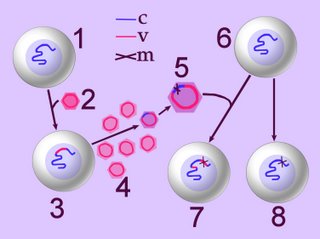retroviruses
Retroviruses employ the RNA-dependent DNA polymerase (reverse transcriptase) within their capsid to replicate their RNA genome into a DNA intermediate, which can be incorporated into the host cell's DNA by an integrase enzyme.
Reverse transcriptase activity, exclusive of retroviral infection, occurs in most eukaryotes, generating and inserting retrotransposons into the host genome. The ability for strand displacement DNA synthesis, unassisted by other proteins, plays an important role in generation of the long terminal repeat sequences in the duplex DNA product of retroviral reverse transcription. Reverse transcriptases are found in retroviruses, retrotransposons, group II introns, bacterial msDNAs, hepadnaviruses, caulimoviruses, and HIV-1. Some 8% of the human genome is composed of endogenous retroviral material, and many endogenous retroviruses participate in control of gene transcription, cell fusion during placental development, and resistance to exogenous retroviral infection.
Right - click to enlarge image – retroviral infection and oncogenesis. 
When a normal cell (1) is infected by a retrovirus (2), the viral reverse transcriptase reverse-transcribes the viral RNA into 'viral' DNA (v), which an integrase randomly integrates (inserts) into the host cell's genome (3-c-v). New viral particles are produced and shed by the infected cell (4) and some of these may contain proto-oncogene fragments of the host's genome (purple virion). Occasionally, the transducted sequence undergoes mutation (m) into an oncogene (5) that is subsequently integrated into the genome of a second normal cell (6), which becomes transformed into a tumorigenic line (7). Under the influence of other carcinogens, normal cells may suffer mutation (m) of a proto-oncogene to an oncogene (8).
Mechanisms of retroviral carcinogenesis:
1. Powerful transcriptional promoter sequences are located at the termini (ends) of the retroviral genome. These sequences are the 'long terminal repeats' (LTRs) that promote the transcription of the viral DNA into new virus particles.
Sometimes, in a process termed transduction, the process of integration causes rearrangement of the viral genome by incorporation of a portion of the host's genome into the viral genome. Occasionally, transduction provides the virus with a host gene that is normally involved in cell cycle control. The gene acquired from the host may be altered during the transduction process, in addition to its being transcribed at a higher rate by virtue of its association with the retroviral LTRs. In such cases, the transduced gene confers a growth advantage to the infected cell, causing the unrestricted cellular proliferation characteristic of tumorigenesis. These transduced host-cell-cycle genes function as oncogenes. The host gene that has been transduced is normally a cellular gene that functions as a proto-oncogene in its unmodified, non-transduced form. The genomes of transforming retroviruses contain numerous oncogenes.
2. Long terminal repeats possess powerful transcription promoting effects. Retroviral genome integration into the host genome occurs randomly. Sometimes this integration process places the LTRs close to a gene that codes for a growth regulating protein. Abnormally elevated levels of expresson of such proteins can induce cellular transformation – 'retroviral integration induced transformation'. HIV induces certain forms of cancers by this integration induced transformation process.
In most cases, cellular transformation by DNA tumor viruses result from viral protein-host protein interaction. Proteins encoded by the DNA tumor viruses are termed tumor antigens or T antigens, and they can interact with cellular proteins. The interaction of T antigens with cellular proteins sequesters the cellular proteins away from their normal functional locations within the cell. Proteins sequestered by viral T antigens are predominantly tumor suppressor proteins, and the loss of their normal suppressor functions results in cellular transformation.
¤ Cancer ¤ carcinogenesis ¤ oncogenes ¤ proliferation ¤ retroviruses ¤ signaling molecules ¤ tumor suppressors ¤ tumorigenic viruses ¤
Tables Malignant Transformation Oncogenes Proto-oncogenes
▲ Top ▲
